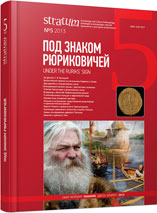Мартон Рошка и археология в Трансильвании: Критические заметки в связи с исследованиями раннесредневекового времени венгерско-армянского учёного
Márton Roska and Archaeology in Transylvania: Critical Notes to the Hungarian-Armenian Scientist’s Early Medieval Studies
Author(s): Erwin GállSubject(s): History, Archaeology, Middle Ages, Philosophy of Science, 6th to 12th Centuries
Published by: Издательский дом Stratum, Университет «Высшая антропологическая школа»
Keywords: Transylvania; Romania; Hungary; Middle Ages; Márton Roska; archaeological research; burial grounds; Gepids; Avars; Magyars
Summary/Abstract: The critical analysis which can be found in Roska’s works and which I find to contain his most important observations is the criticism of Transilvanian archaeology, as hardly any progress has been made since Roska died.When analysing Roska’s works, it is important to note that they showed progress keeping up with his excavations and other excavations relating to that era. His observations show a definite progress from the rigid historical description (as in the second part of the article analysing the cemetery in Várfalva) towards the archaeological observations and analyses.We have divided his archeological studies and analyses into three periods based on their characteristics: 1911—1914 (monographies, the period of historicization); 1927—1936 (the period of syntheses); 1940—1944 (the research of some elements of the material culture in several aspects).Through the above analysis of Roska’s work, we tried to catch a glimpse into some of the major problems of early medieval archaeology and the stage of the research of this problem. Based on the analysis above, we do not find it tragic that 70 or 100 years ago Márton Roska drew rigid ethnic frames or that he did not mention the Avar-Gepid or Avar-Slav relations at all. What we find tragic is the fact that this tendency had hardly changed in the archaeology in Romania until 2011: ethnic frames and general groups, are thought and described to be rigid, stable biological reality and not a fluid social phenomenon and all this huge backwardness in theoretical research is coupled by some with the forced topos of autochtonous-Christian-settled, proto-Romanian and Romanian populations.To sum it up, the problematic questions outlined above do not mean any criticism upon Roska’s scientific level but they prove the backwardness and marginalism of archaeology aſter World War II and at present. This is what should be changed.
Journal: Stratum plus. Археология и культурная антропология
- Issue Year: 2013
- Issue No: 5
- Page Range: 175-196
- Page Count: 22
- Language: Russian
- Content File-PDF

